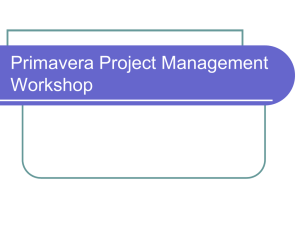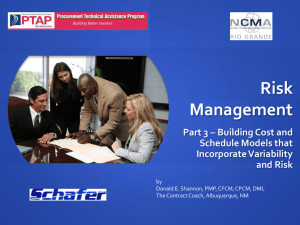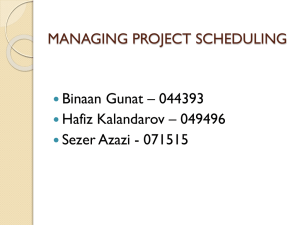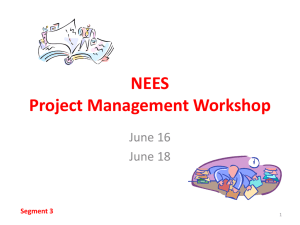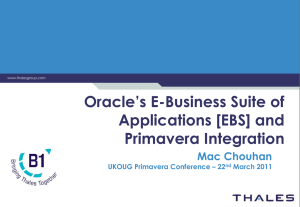Introduction to Primavera
advertisement
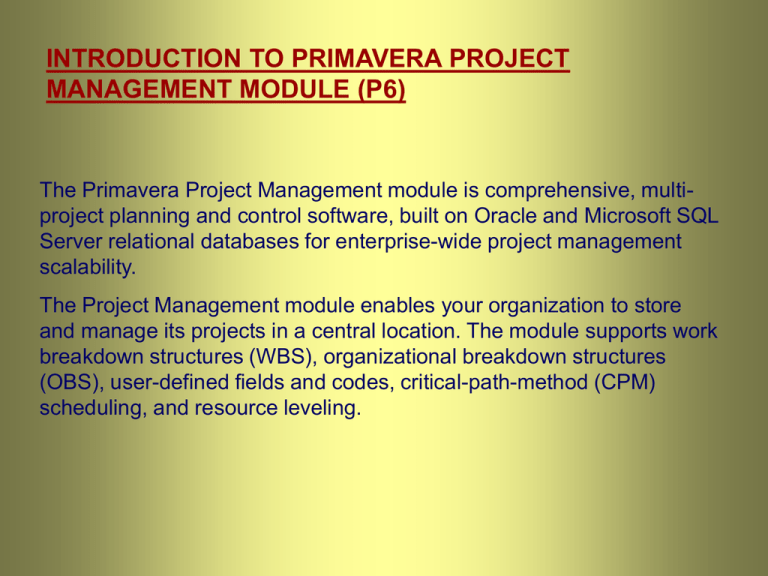
INTRODUCTION TO PRIMAVERA PROJECT MANAGEMENT MODULE (P6) The Primavera Project Management module is comprehensive, multiproject planning and control software, built on Oracle and Microsoft SQL Server relational databases for enterprise-wide project management scalability. The Project Management module enables your organization to store and manage its projects in a central location. The module supports work breakdown structures (WBS), organizational breakdown structures (OBS), user-defined fields and codes, critical-path-method (CPM) scheduling, and resource leveling. Why Primavera is required? • Gives complete Project Management Solution. • Internationally Reputed. • Having Flexibility to Manage Multiple Projects in Centralized location. • Provides facility to Integrate ERP or Accounting System. • It is Web based Project Management gives the project team anywhere, anytime access to the projects they are assigned to work on. • A 100% Web-based user interface covers the full project management lifecycle from project initiation through to project closeout. • It gives the creation of Work Breakdown Structure (WBS) and activities, documenting and managing project risks and issues, managing status updates, and reporting on key performance indicators like earned value. • By using Primavera Project Management, organizations can ensure that the project team members are communicating with each other, whether it is regarding activity status updates, scope changes, revisions to documents, or issue(s) resolution. Advantages of using primavera in comparison with using other conventional planning tools. • • • • • Centralized Project Repository : With all projects are in a centralized database, the robust security module protects project data and offers flexibility when determining who can access each project. Enterprise Project Structure & Codes : A configurable Enterprise Project Structure (EPS) helps forms the hierarchical structure of the projects based on your organizational needs. Extensible Project Codes help capture different attributes of projects, such as the region where the project is being executed or the type of project Cross-project Analysis and Reporting : Quickly and easily create cross-project dependencies and see how projects impact one another. Built-in analysis shows whether resources are over- or under-allocated across projects CPM Scheduling : P6 provides Critical Path Method (CPM) Scheduling, which uses the activity durations, relationships between activities and calendars to calculate a schedule for the project. CPM identifies the critical path of activities, those activities that affect the completion date for the project or an intermediate deadline, and if delayed will delay the finish of the project. Float Path Analysis : Float Path Analysis identifies all critical paths within a project to help avoid potential delays before they occur and to help visualize an activity's importance to overall project plan. Advantages of using primavera in comparison with using other conventional planning tools….. • • • • • • Cross-Project Dependencies : Cross-project dependencies helps to monitor overall critical path of the program and reduces the risk of multiple parties working together. Resource Assignments : When project resources needs have been determined, they can easily be assigned to the schedule activities. P6 tracks labor, material, equipment and expense needs for activities and WBS nodes. ERP or Accounting Integration : The P6 architecture allows for integration with ERP or Accounting Systems so that schedule and cost information can be shared. Resource Leveling : Resource leveling helps ensure that sufficient resources are available to perform the activities in the project plan. Baseline Management : Store unlimited versions of the schedule, resources and cost assignments to compare how the project is progressing vs. the original plan vs. the last update cycle, vs. 6 months ago, etc. Projects Reports : Select from 150+ predefined reports and unlimited custom reports. Offered Products of Primavera for Corporate level Project Management Product Components Power User (Client) Web Projects, Resource Portfolios, Advanced Portfolio & Capacity Planning, Dashboards, Collaboration, Time Sheets. Functional User Web Projects, Resource Portfolios, Advanced Portfolio & Capacity Planning, Dashboards, Collaboration, Time Sheets. Contributor Web Projects limited to activity updating, Collaboration, Time Sheets. Brief about Techniques used for Scheduling Projects CPM – Critical Path Method : The method by which activity durations and the relationships between activities are used to mathematically calculate a schedule for the entire project. CPM focuses attention on the critical path of activities that affect the completion date for the project or an intermediate deadline. Early dates, the earliest possible dates each activity can start and finish, and late dates, the latest possible dates each activity can start and finish without delaying the project finish or an intermediate deadline (constraint) are also calculated. PERT The program evaluation and review technique (PERT) uses the same ideas as CPM; but instead of using just the most likely time estimate, it uses a probabilistic estimate of time for completion of an activity. Integration of Primavera with SAP Motivation Many companies are with project management needs are using SAP as their integrated backbone for enterprise financials & control. Experienced schedulers & Project Managers prefer the project management focus of Primavera Project Planning software for crucial execution processes like planning, scheduling, and execution tracking. Thus, a powerful process integration retains the strengths of both enterprise financials as well as planning, scheduling and enables best use of software packages. Structuring Projects 1. Setting-up and define EPS (Enterprise Project Structure). (EPS) Enterprise Project Structure 2. Add a project to the EPS hierarchy. 3. Defining WBS (Work breakdown structure) to the Project. Projects 4. Defining OBS (Organisational breakdown structure) 5. Defining Resources. (WBS) Work Breakdown Structure 6. Create Calendar for Activities & Resources. 7. Add activities to WBS. Activities 8. Input activity details. 9. Schedule project. 10. Updating progress after project starts. 11. Preview / Print reports (Default / Custom made reports). (OBS) Organisational Breakdown Structures EPS (Enterprise Project Structure) The Enterprise Project Structure (EPS) forms the hierarchical structure of your database of projects. Each EPS node (or folder) can be subdivided into multiple levels to represent the work that needs to be done in your organization. The number of levels and their structure depend on the scope of your projects and how you want to summarize data. EPS create/edit form : Adding project to EPS hierarchy. We can organise unlimited number of Projects in EPS in groups. Project added under Industrial Plants (EPS Node) Example of WBS Structures Project WBS (Work Breakdown Structure) A WBS is a hierarchy of work that must be accomplished to complete a project, which defines a product or service to be produced. The WBS is structured in levels of work detail, beginning with the deliverable itself, and is then separated into identifiable work elements. Civil Works Buildings Roads & Drains Ware House Equipment Fdns Foundation Superstructure Finishing Works Admin Building Mech. Works Tanks Piping Fire Water Tank Diesel Tank Example of OBS Structures President OBS (Organisational Breakdown Structure) The organizational breakdown structure (OBS) is a global hierarchy that represents the managers responsible for the projects in enterprise. The OBS usually reflects the management structure of organization, from top-level personnel down through the various levels constituting your business. We can associate the responsible managers with their areas of the EPS either nodes or individual projects. Regd. Office Engineering Finance HRD & Admin Project Administration GM Finance Sr. GM GM Sr.Manager Design Design Engineer Sites Project Manager Planning & Billing Engineer Engineer Execution Defining Resources. Resources include the personnel and equipment that perform work on activities across all projects. Resources are generally reused between activities and/or projects. Creating Calendars Create and assign calendars to each resource and each activity. These calendars define the available work-hours in each calendar day. We can also specify national holidays, your organization's holidays, project-specific work/nonworkdays, and resource vacation days. Calendar assignments are used for activity scheduling, tracking, and resource leveling. Adding activity to WBS WBS Task / Activity Activity Detail form List of common Inputs / Information to be given to an activity • • • • • • • • • • Activity ID, Name & Type of activity. Start, Finish Dates (Early, Late). Steps of an Activity (Breakdown the activity to smaller units). Relationship between activities (Predecessor, Successor). Resource Assignment (Labour, Non-Labour & Material) Activity Calendar. Constraints. Status of activity (Actual start & finish dates, % of progress). Expenses. Any other comments, notes etc. Scheduling Project • Project schedule can be calculated one of two ways: when we choose the Scheduling command or each time we make a change that affects schedule dates. • The Critical Path Method (CPM) scheduling technique is used to calculate project schedules. CPM uses activity durations and relationships between activities to calculate the project schedule. Updating Progress To update the progress of the individual activity, the following inputs are to be given in the activity detail form. 1. Start Date (If activity is started) 2. Finish Date (If activity is completed) 3. % of duration completed (if activity is in progress) 4. Remaining duration to complete the activity


